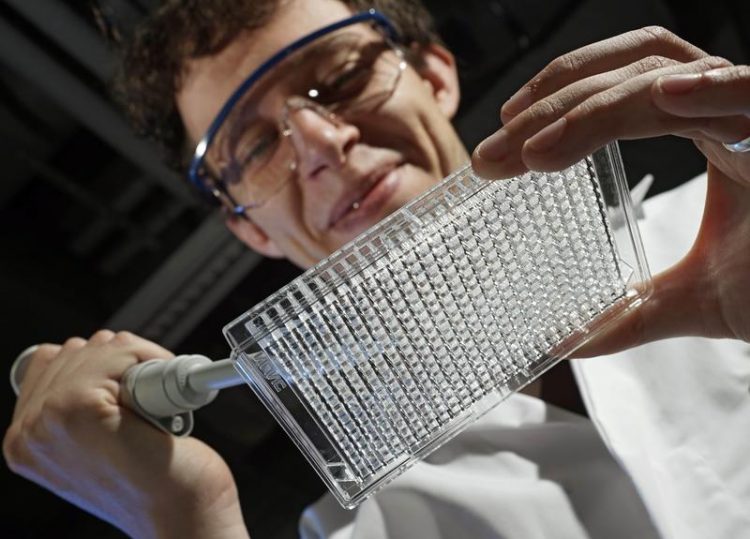The Sweetest Calculator in the World

Chemist Martin Elstner and his colleagues of Jena University use sugar molecules for information processing. photo: Jan-Peter Kasper/FSU
In a chemistry lab at the Friedrich Schiller University Jena (Germany): Prof. Dr. Alexander Schiller works at a rectangular plastic board with 384 small wells. The chemist carefully pipets some drops of sugar solution into a row of the tiny reaction vessels.
As soon as the fluid has mixed with the contents of the vessels, fluorescence starts in some of the wells. What the Junior Professor for Photonic Materials does here – with his own hands – could also be called in a very simplified way, the ‘sweetest computer in the world’. The reason: the sugar molecules Schiller uses are part of a chemical sequence for information processing.
The chemist of Jena University and his two postgraduate students, Martin Elstner and Jörg Axthelm recently described in the new edition of the science journal ’Angewandte Chemie International Edition’ how they developed a molecular computer on the basis of sugar (DOI: 10.1002/anie.201403769).
“The binary logic which makes a conventional computer chip work is based on simple yes/no-decisions,” Professor Schiller explains. “There is either electricity flowing between both poles of an electric conductor or there isn’t.” These potential differences are being coded as “0“ and “1“ and can be linked via logic gates – the Boolean operators like AND, OR, NOT. In this way, a number of different starting signals and complex circuits are possible.
These logic links however can also be realized with the help of chemical substances, as the Jena chemists were able to show. For their ‘sugar computer’ they use several components: One fluorescent dye and a so-called fluorescence quencher. “If there are both components involved, the colorant can’t display its impact and we don’t see a fluorescence signal,” Schiller says.
But if sugar molecules are involved, the fluorescence quencher reacts with the sugar and thus loses its capability to suppress the fluorescence signal, which makes the dye fluorescent. Depending on whether the dye, the fluorescence quencher and the sugar are on hand to give the signal, a fluorescent signal results – “1” – or no signal – “0”.
“We link chemical reactions with computer algorithms in our system in order to process complex information,” Martin Elstner explains. “If a fluorescence signal is registered, the algorithm determines what goes into the reaction vessel next.” In this way signals are not translated and processed in a current flow, like in a computer but in a flow of matter.
That their chemical processing platform works, Schiller and his staff demonstrated in the current study with the sample calculation 10 + 15. “It took our sugar computer about 40 minutes, but the result was correct,“ Prof. Schiller says smiling, and clarifies:
“It is not our aim to develop a chemical competition to established computer chips.” The chemist rather sees the field of application in medical diagnostics. So it is for instance conceivable to connect the chemical analysis of several parameters of blood and urine samples via the molecular logic platform for a final diagnosis and thus enable decisions for therapies.
Original Publication:
Elstner M, Axthelm J, Schiller A. „Sugar-based molecular computing via material implication”, Angewandte Chemie, International Edition 2014, DOI: 10.1002/anie.201403769; German version: Elstner M, Axthelm J, Schiller A. „Zucker-basierter molekularer Rechner mit Implikationslogik”, Angewandte Chemie 2014, DOI: 10.1002/ange.201403769.
Contact:
Prof. Dr. Alexander Schiller
Institute for Inorganic and Analytical Chemistry
Friedrich Schiller University Jena
Humboldtstraße 8, 07743 Jena
Phone: ++49 3641 948113
Email: alexander.schiller[at]uni-jena.de
Media Contact
All latest news from the category: Life Sciences and Chemistry
Articles and reports from the Life Sciences and chemistry area deal with applied and basic research into modern biology, chemistry and human medicine.
Valuable information can be found on a range of life sciences fields including bacteriology, biochemistry, bionics, bioinformatics, biophysics, biotechnology, genetics, geobotany, human biology, marine biology, microbiology, molecular biology, cellular biology, zoology, bioinorganic chemistry, microchemistry and environmental chemistry.
Newest articles

Superradiant atoms could push the boundaries of how precisely time can be measured
Superradiant atoms can help us measure time more precisely than ever. In a new study, researchers from the University of Copenhagen present a new method for measuring the time interval,…

Ion thermoelectric conversion devices for near room temperature
The electrode sheet of the thermoelectric device consists of ionic hydrogel, which is sandwiched between the electrodes to form, and the Prussian blue on the electrode undergoes a redox reaction…

Zap Energy achieves 37-million-degree temperatures in a compact device
New publication reports record electron temperatures for a small-scale, sheared-flow-stabilized Z-pinch fusion device. In the nine decades since humans first produced fusion reactions, only a few fusion technologies have demonstrated…





















